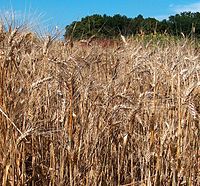
Photo from wikipedia
Revival of natural colorants in textile dyeing is one of the important strategies to reduce synthetic chemical-based environmental pollution. The study has been conducted to explore the coloring potential of… Click to show full abstract
Revival of natural colorants in textile dyeing is one of the important strategies to reduce synthetic chemical-based environmental pollution. The study has been conducted to explore the coloring potential of durum (Triticum durum Desf.) and bread (Triticum astivum L.) wheat husk for fabric dyeing. The results showed that both wheat species husk could be an excellent source of natural dye, if extracted in alkaline medium. It has been observed that durum wheat husk based dye worked best at 70°C with a pH 11.0 and salt concentration of 8.0 g/100 ml of solution. Similarly, alkaline extract of bread wheat husk worked better at 80°C with dyeing solution pH 9.0 and salt concentration of 8.0 g/100 ml. Bio-mordanting experiments results revealed pomegranate rind (7%) as most effective bio-mordant to obtain high color strength of wheat husk treated fabric. In chemical-mordanting, tannic acid (5%) as pre-mordant and chrome (5%) as post-mordant have improved the color strength more than all other quantities of employed mordants. FTIR analysis indicated the presence of flavonoids as major colorant compounds in wheat husk–based natural dye. Suggested ISO standards for colorfastness illustrated good color strength ratings of husk-based dyed fabric when treated with bio-mordants as compared to chemical counterparts. Hence, husk of both bread and durum wheat species has great potential to be used as source of eco-friendly natural colorant for cotton dyeing.
Journal Title: Environmental Science and Pollution Research
Year Published: 2021
Link to full text (if available)
Share on Social Media: Sign Up to like & get
recommendations!